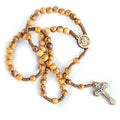The Church of the Nativity in Bethlehem and the Symbolism of Olive Wood

The Church of the Nativity, situated in the heart of Bethlehem, is a revered site for Christians around the world, believed to be the birthplace of Jesus Christ. The Nativity Church is one of the oldest working churches in existence today. This ancient basilica was commissioned by Constantine the Great in the 4th century and stands as a monumental symbol of divine incarnation. Constantine, along with his mother Saint Helena, initially constructed a grand church at the site, featuring exquisite marble and mosaics. In the 6th century, Byzantine Emperor Justinian rebuilt an even more elaborate structure on the same location. Remarkably, during the Persian invasion of the 7th century, the church was spared from destruction. By the 11th century, the Crusaders took control of the Basilica of the Nativity, raising their flag over it and undertaking renovations to restore and enhance its grandeur.
The main entrance to the Church of the Nativity was gradually made lower and narrower in order to protect it from invaders. Two sets of stairs lead down
The church is characterised by its humble entrance, the Door of Humility, which requires visitors to bow as they enter, symbolising reverence and humility before God. Inside, the church is adorned with ancient mosaics and majestic columns, creating an atmosphere that reflects centuries of devotion. Beneath the main altar lies the Grotto of the Nativity, where a silver star embedded in the marble floor marks the spot traditionally recognized as the birthplace of Jesus. This sacred site, now a UNESCO World Heritage Site, continues to attract millions of pilgrims every year, who come to connect with the profound history and spiritual significance of this holy place.
Entrance to the Church of the Nativity

Door of Humility of the Church of the Nativity

Inside the Nativity Church

Grotto of the Nativity

Bethlehem: A City of History and Faith
Bethlehem, often referred to as the "City of David," holds a unique position in both Christian and Jewish traditions. It is not only the birthplace of Jesus Christ but also the birthplace of King David, Israel's greatest king, and the setting for the story of Ruth and Boaz. This rich biblical history makes Bethlehem a city of immense religious and cultural significance. Today, Bethlehem is a vibrant town where the ancient and modern worlds intersect. Its bustling markets, historic churches, and welcoming community reflect the town’s deep-rooted heritage and ongoing significance as a center of Christian pilgrimage. Visitors to Bethlehem can explore its historical sites, participate in traditional ceremonies, and experience the rich tapestry of life in this ancient city.
The Connection Between Bethlehem and Olive Wood
Bethlehem is also renowned for its rich tradition of olive wood craftsmanship, an art form that has been practiced for centuries. The ancient olive trees surrounding the town provide the raw material for the creation of beautiful religious artefacts, such as olive wood crosses, rosaries, and nativity scenes. This craft is more than just a local industry; it is a symbol of the deep spiritual heritage of the region.
Olive wood, with its distinctive grain and warm hue, is cherished for its beauty and durability. Artisans in Bethlehem meticulously carve each piece, infusing their work with both artistic skill and spiritual devotion. The wood’s connection to the Holy Land makes these items deeply meaningful for Christians around the world, serving as tangible links to the life of Christ and the land where He was born and ministered.
Symbolism and Spiritual Significance
Olive wood carries profound symbolism in the Christian faith. The olive tree itself is a symbol of peace, endurance, and divine blessing, often mentioned in the Bible as a representation of God’s promise and faithfulness. In the Gospels, Jesus prays beneath the shade of olive trees in the Garden of Gethsemane, a moment of profound surrender and strength before His arrest. Thus, the use of olive wood from Bethlehem, the city of His birth, in crafting religious items such as blessed crosses and crucifixes and rosaries, serves as a powerful reminder of Jesus's life, His teachings, and His sacrifice. These items become not just artefacts but vessels of faith, inviting believers to meditate on the mysteries of Christ's life and the enduring hope symbolized by the olive tree.
Supporting Local Christian Communities
The tradition of olive wood carving in Bethlehem is not only a spiritual practice but also a critical source of livelihood for many Christian families in the region. The artisans, who often come from families with a long history of this craft, depend on this trade to support their communities amidst economic challenges. By purchasing olive wood products, such as crosses and rosaries, visitors and believers around the world help sustain these local craftsmen, ensuring the survival of this ancient art form. This support goes beyond financial aid; it helps preserve a cultural and spiritual heritage that is deeply connected to the Christian faith and the history of the Holy Land. For many artisans, their work is a form of devotion, a way to express their faith through their craft and share a piece of the Holy Land with the world.
A Symbolic Gift from the Holy Land
Owning a piece of olive wood from Bethlehem is more than just possessing a beautiful object; it is holding a tangible link to the Holy Land and the life of Christ. Whether it is a simple olive wood cross, a detailed nativity scene, or a rosary, each item carries the spirit of Bethlehem and the legacy of Jesus’s birth and ministry. These items are cherished by Christians worldwide as symbols of their faith and as reminders of the sacred land where their beliefs were born. They are often given as meaningful gifts, connecting the receiver to the Holy Land and the deeper truths of their faith. In this way, the olive wood products of Bethlehem continue to inspire and nurture the faith of those who hold them, serving as enduring symbols of the love, peace, and resilience at the heart of the Christian message.
Conclusion: A Testament to Faith and Craftsmanship
The Church of the Nativity and the olive wood tradition of Bethlehem are deeply intertwined, representing the rich spiritual and historical heritage of this sacred city. Together, they offer a unique connection to the events of the Christian faith, inviting believers to experience the sacredness of Bethlehem through pilgrimage and through the cherished olive wood artifacts that serve as symbols of this holy land. As pilgrims journey to the Church of the Nativity to honor the birthplace of Christ, and as they carry home olive wood crosses and other religious items, they participate in a tradition that spans centuries, linking them to the deep faith and devotion of the generations who have come before them.
SHARE:





















